On Dec. 8, 2022, New York City Mayor Eric Adams outlined his "Get Stuff Built" initiative to "add hundreds of thousands of units to address the [the housing crisis]," including loosening administrative hurdles required in connection with rezonings, special permits, and other discretionary actions. This is great news for zoning and land use practitioners—the faster the better! However, in the interim as these proposals take shape, this article focuses on the hidden, as-of-right, no discretionary interference method to maximize development potential: The transfer of air rights (technically, the transfer of "floor area") from one tax lot to another.
When I first began my career, my understanding of an air rights deal was a way for a big-time developer and a mom-and-pop, one-story business to somehow both make a windfall. One party sitting on unused value and one party capable of realizing such value seemed like a win-win (and still does). So, to understand more, I opened up the Zoning Resolution to see how it facilitated an air rights deal. Surely, there must be an explicit provision, with headers, multiple paragraphs, sub-paragraphs, sub-sub paragraphs, and footnotes (the Zoning Resolution is a comprehensive and dense statute!). I performed the obligatory search for all the terms I could think of, "transfer," "air," "development," "rights." I found some hits! Transfer of Development Rights from Landmark Sites. Transfer of Development Rights from a Listed Theater. Transfer of Development Rights from the High Line Transfer Corridor. Nope. Though all interesting in their own right, they were not applicable to your typical mom-and-pop deal.
I must have been missing something. And yes, I was. The transfer of air rights is accomplished through the guidance of the Zoning Resolution's definition of "zoning lot." Most individual tax lots are also a single individual zoning lot. They are one and the same. The Zoning Resolution regulates the amount of floor area (a.k.a., "development rights") that can be developed on such individual zoning lot by multiplying the lot area of the zoning lot, times the maximum permitted floor area ratio (FAR) for the zoning district underlying the zoning lot. If Site A (the development site) is a 10,000 square foot tax/zoning lot (see Figure 1), and the maximum FAR is 5.0, then 50,000 square feet of floor area may be developed on Site A (see Figure 2).
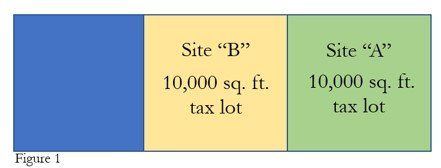
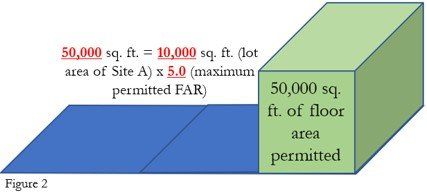
The mom-and-pop store is located on Site B. Site B is also a 10,000 square foot lot and located in a zoning district with the same FAR as Site A. Therefore, as was the case with Site A, Site B may also be developed with 50,000 square feet of floor area. Since Site B is improved with only 10,000 square feet (one-story store), there is 40,000 square feet of unused and available floor area (see Figure 3).
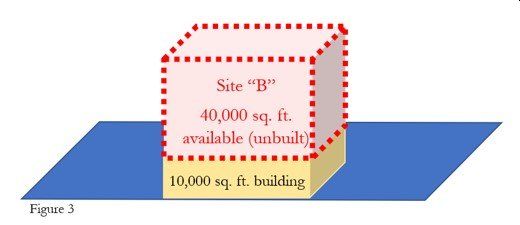
If Site A and Site B are merged into a single zoning lot (while retaining their individual fee ownership interests), the lot area of such zoning lot is 20,000 square feet. Therefore, 100,000 square feet of floor area is permitted on the single, merged zoning lot (see Figure 4).
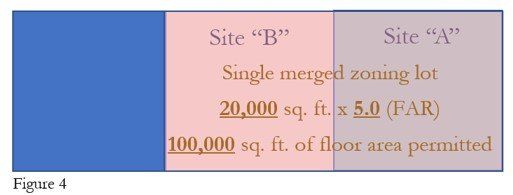
Now, for the exciting conclusion! With 10,000 sq. ft. already constructed on Site B, there is 90,000 square feet of floor area available on the single merged zoning lot, all of which may developed on Site A (see Figure 5).
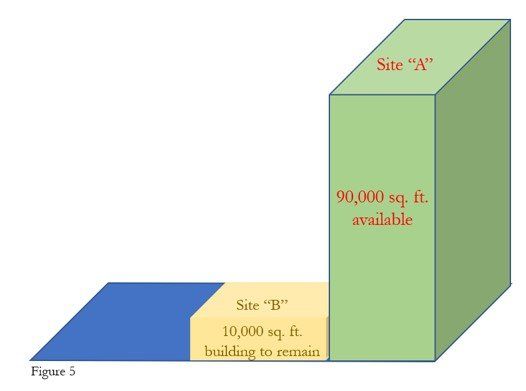
That's the nitty gritty of the air rights concept (with the understanding that Site A and Site B mustbe contiguous for at least 10 linear feet and be located in a zoning district with the same FAR regulations). So, when you look at the Manhattan skyline with the new pencil towers on Central Park, you can now tell your friends that was all done by the merging of tax lots into a single zoning lot. In fact, the 98-story Central Park Tower (225 West 57th Street) was constructed on a single tax lot, yet on a merged zoning lot that included the tax lots comprising almost the entirety of the block between West 57th and 58th Streets between 7th Avenue and Broadway.
How is the zoning lot merger legally effectuated? The answer is also found in the Zoning Resolution's definition of "zoning lot," which in its own unique and roundabout way states that a zoning lot may be comprised of two or more tax lots in separate ownership, provided such fee owners and all other parties-in-interest (e.g., lenders, long-term tenants, ROFR, and other lien holders) sign, or waive their right to sign, a Declaration of Zoning Lot Restrictions (a.k.a., Exhibit IV), a recorded document declaring that the multiple tax lots are a single zoning lot. Other zoning lot exhibits are also required to be recorded, and in your typical air rights deal, include an Exhibit II Title certification (listing the parties-in-interest), Exhibit III ownership statement and Exhibit V, party-in-interest waiver of executing, and agreeing that its interest is subordinate to, the Declaration of Zoning Lot Restrictions.
There are also creative ways to create a single zoning lot, specifically when one parcel (with available floor area) is not contiguous with a development site. This is done by merging the development site with the non-contiguous parcel, by incorporating an intervening, or pass-thorough lot, which is contiguous with the development site. Obviously, the intervening lot will want to be compensated as acting as the pass-through lot. Some practitioners refer to this as a toll fee, which a developer is happy to pay to unlock a package of valuable development rights.
It is important to note that a merged zoning lot may not only be limited to the transfer of development rights. A zoning lot merger may be utilized to increase the amount of signage on a parcel (as surface area is based on the frontage of a zoning lot), enable a new building to comply with lot coverage and open space requirements, or to create a light and air easement over a particular parcel in order to accommodate legal light and air on a lot line.
Finally, in order to protect the developer or the mom-and-pop business, a Zoning Lot Development Agreement (ZLDA) should be prepared and recorded, setting forth the amount of floor area to be transferred and each owner's rights and responsibilities in effectuating the transfer. A ZLDA, although imperative to protect your client's interest, is not required by the Zoning Resolution to properly effectuate a merged zoning lot.
Until Mayor Adams' administration eases the way for rezonings and special permits, why not take advantage of the as-of-right transfer of development rights to create value for your clients, right out of thin air!
Originally Published by New York Law Journal
The content of this article is intended to provide a general guide to the subject matter. Specialist advice should be sought about your specific circumstances.
